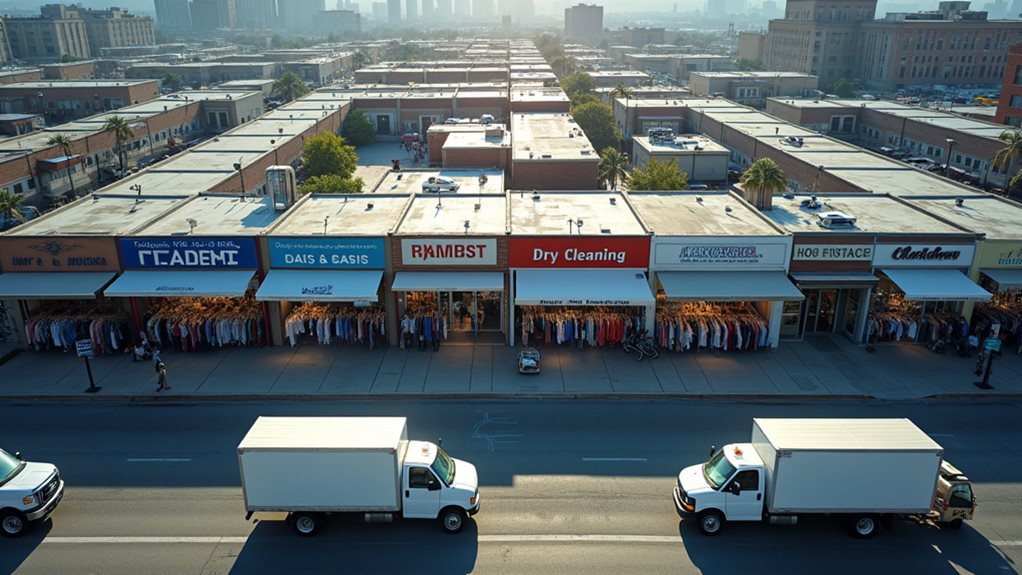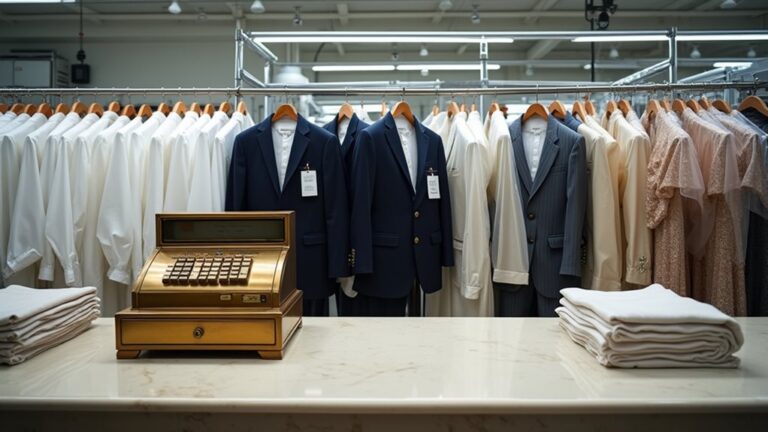The global dry cleaning market isn’t just surviving—it’s actually thriving at $67.2 billion as of 2022, and honestly, that surprised me too given how we’re all working from home in sweatpants these days. You’re looking at steady growth projected to hit $103.5 billion by 2030, driven by busy professionals, urbanization, and those delicate fabrics that need expert care. There’s fascinating regional variation and innovation happening that’ll reshape this industry completely.
Global Market Size and Revenue Projections
Three fascinating insights emerge when you explore the dry cleaning market‘s financial terrain, and honestly, the numbers might surprise you more than finding that twenty-dollar bill in your winter coat pocket.
The global market reached $67.2 billion in 2022, with projected growth targeting $103.5 billion by 2030 – that’s a solid 5.5% CAGR that’d make your investment advisor smile.
Different industry statistics paint slightly varying pictures, but they’re all singing the same tune: steady upward momentum.
The demand for laundry services keeps climbing, especially in commercial laundry sectors serving hospitality and healthcare.
These revenue projections reflect our evolving relationship with clothing care, where busy lifestyles meet specialized dry-cleaning services, creating a market size that’s both impressive and surprisingly resilient.
The United States represents a significant portion of this global market, contributing approximately $8-10 billion to the industry total, demonstrating the continued importance of professional garment care in developed economies.
Industry Growth Rates and Market Trends

While market projections might seem like dry statistics at first glance, the growth patterns in this industry tell a compelling story about how we’re reshaping our relationship with clothing care in the modern world.
You’ll notice the dry cleaning market‘s showing impressive resilience, with CAGR rates consistently hovering between 3.4% and 5.5% across different segments.
What’s fascinating is how laundry services are outpacing traditional dry cleaning, hitting a robust 6% CAGR as we increasingly value convenience over DIY approaches.
The commercial laundry sector‘s particularly telling this story well, growing at 4.35% annually as hotels and restaurants recognize outsourcing’s benefits.
These industry trends directly mirror our economic conditions—when consumer spending rises and unemployment drops, demand for professional clothing care naturally follows, creating this beautiful cycle of growth.
The U.S. market’s substantial presence is evident in its $8-10 billion annual revenue generation, demonstrating the sector’s significant contribution to the broader service economy.
Key Market Drivers and Consumer Demand Factors

Behind these impressive growth numbers, you’ll find some pretty fascinating forces at work that reveal just how much our daily lives have changed over the past decade.
The dry cleaning market’s expansion stems from increased disposable income among working professionals who desperately need demand for clean garments to maintain their image. Urbanization has created time-starved consumers who gladly outsource laundry services, while economic growth in emerging markets fuels specialty cleaning services adoption.
Single-person households can’t justify buying commercial-grade equipment, so they rely on professional care for delicate fabrics.
Perhaps most telling, shifting consumer preferences toward eco-friendly cleaning methods reflect our growing awareness of personal hygiene and environmental responsibility – showing that even mundane tasks like cleaning clothes mirror broader societal values. The industry’s widespread reach is evident in that approximately 30,000 to 35,000 dry cleaning establishments currently operate across the United States, serving the estimated 70% of American households that use these services.
Regional Market Analysis and Distribution

When you look at the dry cleaning market‘s geographic footprint, you’ll discover that North America absolutely dominates the terrain with a commanding $17.8 billion market share in 2022. This dominance is largely because American and Canadian consumers have adopted the convenience culture that makes professional garment care feel less like a luxury and more like a necessity.
However, don’t sleep on Asia Pacific – this region’s about to shake things up with China racing toward $17 billion by 2030 at an impressive 7% growth rate.
Europe’s holding steady too, with Germany pushing forward at 5.1% CAGR as disposable income rises.
The commercial segment, especially the hospitality industry, drives demand for laundry services across these regions, creating opportunities everywhere you turn in this regional market analysis. The United States alone operates approximately 35,000-40,000 establishments that serve millions of customers through both independent shops and larger chain operations.
Major Players and Competitive Landscape

The competitive battlefield of this $60.88 billion industry tells a fascinating story about how smart positioning and innovation can make or break your success in what might seem like a traditional business.
With around 120 players vying for market share, you’ll find major companies like Rinse, Inc., ZIPS Dry Cleaners, and Tide Cleaners aren’t just competing on price anymore.
They’re embracing environmentally friendly practices, leveraging cutting-edge technology, and reimagining service accessibility to meet evolving consumer demands.
The dry cleaning market’s 3.4% growth rate rewards those who understand that profitability comes from differentiating yourself in this competitive environment through meaningful innovations that actually solve real problems for busy customers.
While the industry has adapted to challenges from changing fashion trends toward casual wear and remote work impacts, it continues to thrive through pickup/delivery services and specialized care for luxury items and special occasion garments.




